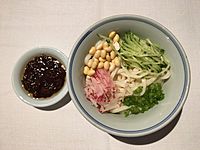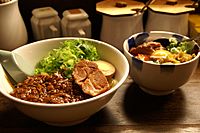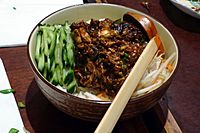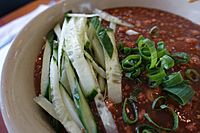Zhajiangmian facts for kids
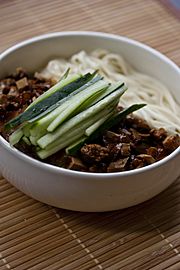 |
|
| Type | Chinese noodles |
|---|---|
| Place of origin | China |
| Region or state | Shandong |
| Main ingredients | cumian, diced pork or ground pork, fermented soybean paste |
| Zhajiangmian | |||||||||
|---|---|---|---|---|---|---|---|---|---|
| Chinese name | |||||||||
| Simplified Chinese | 炸酱面 | ||||||||
| Traditional Chinese | 炸醬麵 | ||||||||
| Literal meaning | fried sauce noodles | ||||||||
|
|||||||||
| Korean name | |||||||||
| Hangul | 작장면/자장몐 | ||||||||
| Japanese name | |||||||||
| Kanji | 炸醤麺 | ||||||||
| Kana | ジャージャー麺 | ||||||||
Zhajiangmian (simplified Chinese: 炸酱面; traditional Chinese: 炸醬麵) is a popular Chinese noodle dish. Its name means "fried sauce noodles." This dish features thick wheat noodles topped with a special sauce called zhajiang.
The zhajiang sauce is made by cooking stir-fried diced meat, usually pork or beef, with a salty fermented soybean paste. The word zhajiang itself means "fried sauce" in Chinese.
People often add fresh or pickled vegetables on top of the noodles. These can include cucumber, radish, and edamame. Sometimes, chopped omelette or firm tofu is also added. For those who prefer less fat, minced chicken can be used instead of pork or beef.
Where Did Zhajiangmian Come From?
The Dish's Beginnings
Zhajiangmian started in the Shandong province of China. It is a very famous dish in Northern China. No one knows exactly how the dish began. There are only a few old stories about its origin.
How Vegetarian Zhajiangmian Reached Beijing
A long time ago, during the Qing dynasty, China was invaded. The Empress Dowager Cixi and Emperor Guangxu had to leave Beijing. On their journey, a palace helper named Li Lianying smelled something delicious. He found a restaurant selling zhajiangmian.
Cixi and Guangxu were tired and hungry. They decided to eat at the restaurant. Li Lianying ordered a bowl of vegetarian zhajiangmian for them. They found it very tasty and ordered another bowl. After their meal, Cixi asked everyone if they liked the dish. They all said it was "good, good!"
Before leaving, Cixi asked Li Lianying to bring the chef to Beijing. She wanted to eat zhajiangmian often when they returned to the palace. This is how the vegetarian version of zhajiangmian became popular in Beijing.
Different Kinds of Zhajiangmian
Zhajiangmian has many different styles across China and even in other countries. Each region puts its own spin on the sauce and toppings.
Shandong Style
In Shandong cuisine, the sauce is made with a special sweet flour paste called tianmianjiang. This version is often seen as the original or standard way to make zhajiangmian in China.
Beijing Style
In Beijing cuisine, the sauce uses both yellow soybean paste and tianmianjiang. When the sauce is cooked, lots of white scallions are added. Diced pork is used instead of ground meat. This dish is usually served with many crunchy vegetables. These include cucumber, radish, bean sprouts, and celery. Thick, handmade noodles are preferred for this style. Beijing-style Zhajiangmian is the most famous version in China.
Sichuan Style
In Sichuan cuisine, there's a similar dish called Zajiangmian (杂酱面). It uses ground meat instead of diced meat. A spicy bean paste called doubanjiang is also added to the sauce. This makes the sauce a bit thinner and less salty. Boiled leafy vegetables are served with the noodles. Sichuan Zajiangmian is often served in a soup. Sometimes, it's mixed directly with the sauce. People usually add chili oil and chopped green onions on top.
Northeast China Style
In areas like Liaoning and Jilin, the zhajiang sauce is traditionally made with Dajiang sauce. Ground meat is commonly used here. There are also special versions without meat. These are called 'Egg Zhajiang' and 'Egg and Green Chili Zhajiang'.
Cantonese Style
In Hong Kong cuisine, people add ketchup and chili sauce to the basic zhajiang sauce. This gives it a slightly sweet, spicy, and sour taste.
Vegetarian Zhajiangmian
A vegetarian version of zhajiang sauce can be made. Instead of meat, finely diced smoked tofu, edamame, or eggplant are used. These vegetarian sauces usually use soybean paste instead of soy sauce. This helps the tofu chunks hold their shape better.
Halal Zhajiangmian
A halal version is often made for Muslim eaters. It uses ground beef or lamb instead of pork.
Zhajiangmian in South Korea
In South Korea, zhajiangmian changed into a dish called Jajangmyeon. This happened when workers from Shandong came to Korea.
Zhajiangmian in Japan
In Japan, zhajiangmian became jajamen (じゃじゃ麺). It was brought from Northeast China. It's a very popular dish in the city of Morioka, Iwate. It's known as one of Morioka's three great noodle dishes.
See also
 In Spanish: Zha jiang mian para niños
In Spanish: Zha jiang mian para niños


